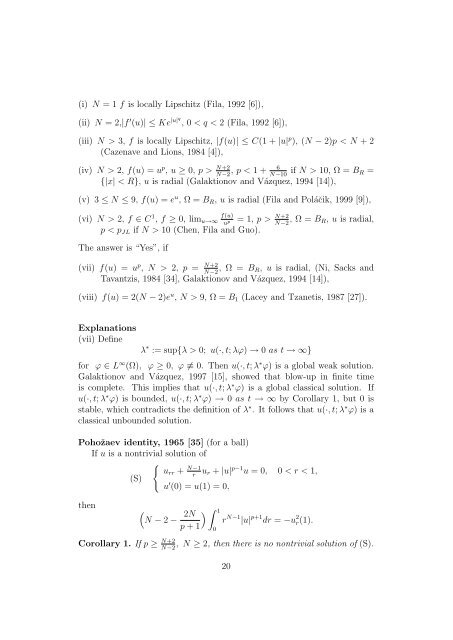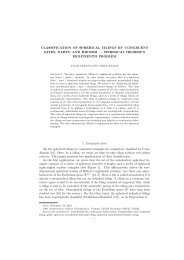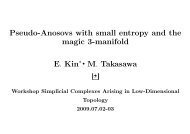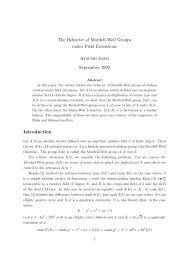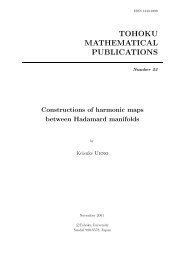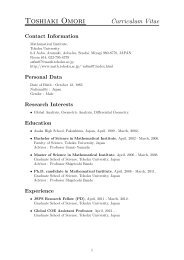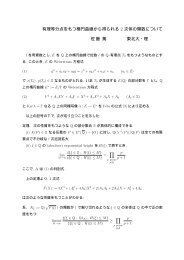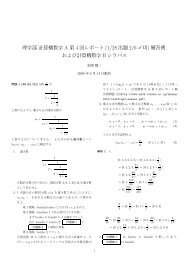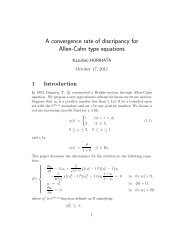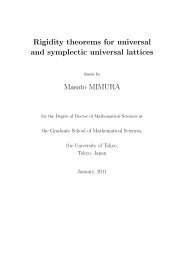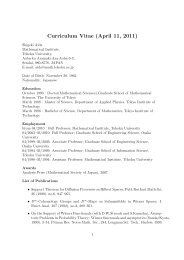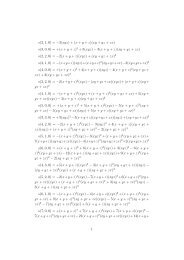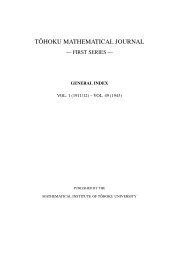Blow-up of Solutions of Semilinear Parabolic Equations
Blow-up of Solutions of Semilinear Parabolic Equations
Blow-up of Solutions of Semilinear Parabolic Equations
You also want an ePaper? Increase the reach of your titles
YUMPU automatically turns print PDFs into web optimized ePapers that Google loves.
(i) N = 1 f is locally Lipschitz (Fila, 1992 [6]),<br />
(ii) N = 2,|f ′ (u)| ≤ Ke |u|q , 0 < q < 2 (Fila, 1992 [6]),<br />
(iii) N > 3, f is locally Lipschitz, |f(u)| ≤ C(1 + |u| p ), (N − 2)p < N + 2<br />
(Cazenave and Lions, 1984 [4]),<br />
(iv) N > 2, f(u) = u p , u ≥ 0, p > N+2,<br />
p < 1 + 6 if N > 10, Ω = B N−2 N−10 R =<br />
{|x| < R}, u is radial (Galaktionov and Vázquez, 1994 [14]),<br />
(v) 3 ≤ N ≤ 9, f(u) = e u , Ω = B R , u is radial (Fila and Poláčik, 1999 [9]),<br />
(vi) N > 2, f ∈ C 1 f(u)<br />
, f ≥ 0, lim u→∞ = 1, p > N+2,<br />
Ω = B u p N−2 R, u is radial,<br />
p < p JL if N > 10 (Chen, Fila and Guo).<br />
The answer is “Yes”, if<br />
(vii) f(u) = u p , N > 2, p = N+2<br />
N−2 , Ω = B R, u is radial, (Ni, Sacks and<br />
Tavantzis, 1984 [34], Galaktionov and Vázquez, 1994 [14]),<br />
(viii) f(u) = 2(N − 2)e u , N > 9, Ω = B 1 (Lacey and Tzanetis, 1987 [27]).<br />
Explanations<br />
(vii) Define<br />
λ ∗ := s<strong>up</strong>{λ > 0; u(·, t; λϕ) → 0 as t → ∞}<br />
for ϕ ∈ L ∞ (Ω), ϕ ≥ 0, ϕ ≢ 0. Then u(·, t; λ ∗ ϕ) is a global weak solution.<br />
Galaktionov and Vázquez, 1997 [15], showed that blow-<strong>up</strong> in finite time<br />
is complete. This implies that u(·, t; λ ∗ ϕ) is a global classical solution. If<br />
u(·, t; λ ∗ ϕ) is bounded, u(·, t; λ ∗ ϕ) → 0 as t → ∞ by Corollary 1, but 0 is<br />
stable, which contradicts the definition <strong>of</strong> λ ∗ . It follows that u(·, t; λ ∗ ϕ) is a<br />
classical unbounded solution.<br />
Pohožaev identity, 1965 [35] (for a ball)<br />
If u is a nontrivial solution <strong>of</strong><br />
{<br />
urr + N−1 u<br />
r r + |u| p−1 u = 0, 0 < r < 1,<br />
(S)<br />
u ′ (0) = u(1) = 0,<br />
then<br />
(<br />
N − 2 − 2N ) ∫ 1<br />
p + 1<br />
0<br />
r N−1 |u| p+1 dr = −u 2 r(1).<br />
Corollary 1. If p ≥ N+2 , N ≥ 2, then there is no nontrivial solution <strong>of</strong> (S).<br />
N−2<br />
20


